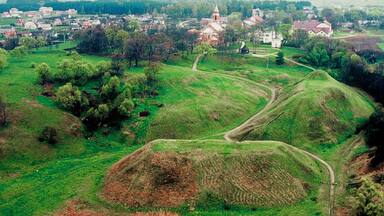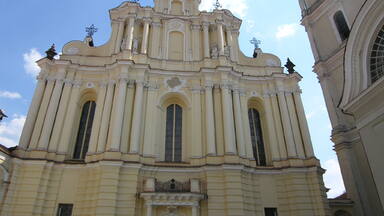Kernavė Archaeological Site (Cultural Reserve of Kernavė)
Kernavė Archaeological Site (Cultural Reserve of Kernavė)
The Kernavė Archaeological site, about 35 km north-west of Vilnius in eastern Lithuania, represents an exceptional testimony to some 10 millennia of human settlements in this region. Situated in the valley of the River Neris, the site is a complex ensemble of archaeological properties, encompassing the town of Kernavė, forts, some unfortified settlements, burial sites and other archaeological, historical and cultural monuments from the late Palaeolithic Period to the Middle Ages. The site of 194,4 ha has preserved the traces of ancient land-use, as well as remains of five impressive hill forts, part of an exceptionally large defence system. Kernavė was an important feudal town in the Middle Ages. The town was destroyed by the Teutonic Order in the late 14th century, however the site remained in use until modern times.
Description is available under license CC-BY-SA IGO 3.0
Site archéologique de Kernavė (Réserve culturelle de Kernavė)
Le site de Kernavė, dans l’est de la Lituanie à 35 km environ de Vilnius, représente le témoignage exceptionnel d’établissements humains dans la région sur une période de 10 000 ans. Situé dans la vallée de la Neris, le site est un ensemble complexe de biens archéologiques, historiques et culturels englobant la ville de Kernavė, des forts, des installations non fortifiées, des sites funéraires et d’autres monuments archéologiques depuis la fin du paléolithique jusqu’au Moyen Âge. Ce site de 194,4 ha conserve les traces d’anciennes occupations des sols ainsi que les vestiges de cinq collines fortifiées qui faisaient partie d’un système de défense d’une envergure exceptionnelle. Au Moyen Âge, Kernavė était une ville féodale importante. Elle fut détruite par l’ordre Teutonique à la fin du XIVe siècle, mais le site est resté en activité jusqu’à l’époque moderne.
Description is available under license CC-BY-SA IGO 3.0
الموقع الأثري في كيرنافي (المحمية الثقافية في كيرنافي)
يمثّل موقع كيرنافي الذي يقع في شرق ليتوانيا والذي يبعد 35 كيلومترًا تقريبًا عن فيلنيوس، الشاهد بامتياز على المنشآت التي قام بها الإنسان في المنطقة على مدار 10000 سنة. فهذا الموقع الذي يقع في وادي نيريس هو مجموعة مركبة من الثروات الأثريّة والتاريخيّة والثقافيّة التي تتضمَّن مدينة كيرنافي وعدة قلاع وإمدادات غير محصّنة ومواقع مأتميّة ونصب أثرية أخرى منذ نهاية العصر الحجري حتى العصور الوسطى. وقد حافظ هذا الموقع الذي تصل مساحته إلى 194.4 هكتار على آثار احتلالات الأراضي القديمة، بالإضافة إلى آثار خمس تلال محصنة كانت جزءًا من نظام الدفاع الواسع النطاق. في العصور الوسطى، كانت كيرنافي مدينةً إقطاعيّةً مهمّةً دمّرها النظام التوتوني في نهاية القرن الرابع عشر، ولكن الموقع تابع نشاطه حتى العصر الحديث.
source: UNESCO/CPE
Description is available under license CC-BY-SA IGO 3.0
克拿维考古遗址(克拿维文化保护区)
克拿维考古遗址位于立陶宛东部,在维尔纽斯西北约35公里处,是该地区人类居住约10 000年历史的特别例证。遗址群坐落在涅里斯河谷地,包括克拿维城、堡垒、一些未设防的居住地、墓地和从旧石器时代晚期到中世纪时其他的考古、历史和文化遗迹。该遗址面积为194.4公顷,保留有古代土地使用的遗迹,还有五个山上堡垒(大型防御系统的一部分)的残留部分。克拿维是中世纪一个重要的封建城镇。 虽然该城在14世纪晚期受到条顿骑士团规约的破坏,但是直到现代还在继续使用中。
source: UNESCO/CPE
Description is available under license CC-BY-SA IGO 3.0
Археологические памятники культурного резервата Кярнаве
Этот комплексный объект, расположенный в долине реки Нярис, включает археологические остатки древнего города Кярнаве, фортов, нескольких неукрепленных поселений, а также захоронений и иных памятников, относящихся к периоду времени от позднего палеолита до средневековья. Здесь можно наблюдать следы древнего землепользования, а также остатки пяти древних укрепленных городищ, являющихся частью мощной оборонительной системы. Кярнаве был важным феодальным городом в Средние века. И хотя город был разрушен рыцарями Тевтонского Ордена в конце XIV в., это место еще было населено на протяжении длительного времени.
source: UNESCO/CPE
Description is available under license CC-BY-SA IGO 3.0
Sitio arqueológico de Kernavė (Reserva cultural de Kernavė)
El sitio arqueológico de Kernavė se halla en la parte oriental de Lituania, a unos 35 kilómetros al noroeste de Vilna, y constituye un testimonio excepcional de los asentamientos humanos en la región a lo largo de un periodo de diez mil años. Emplazado en el valle del río Neris, este sitio está integrado por un conjunto de vestigios arqueológicos, históricos y culturales, entre los que figuran: la ciudad de Kernavė, una serie de fortificaciones, varios asentamientos no fortificados, diversos centros funerarios y otros monumentos arqueológicos cuya datación va del Paleolítico hasta la Edad Media. El sitio se extiende por una superficie de 194,5 hectáreas y conserva huellas de poblamientos muy antiguos, así como los restos de cinco colinas fortificadas que formaban parte de un sistema de defensa de envergadura excepcional. Kernavė fue una ciudad feudal de gran importancia en la Edad Media y siguió siendo escenario de actividades hasta la época moderna, a pesar de que fue destruida por la Orden Teutónica a finales del siglo XIV.
source: UNESCO/CPE
Description is available under license CC-BY-SA IGO 3.0
ケルナヴェ古代遺跡(ケルナヴェ文化保護区)
source: NFUAJ
Archeologisch gebied Kernavė (Cultuurreservaat van Kernavė)
Source: unesco.nl
Outstanding Universal Value
Brief synthesis
Kernavė Archaeological Site, situated in the valley of the River Neris in eastern Lithuania, provides evidence of human settlements spanning some 10 millennia. Covering an area of 194.4 ha, the property contains archaeological evidence of ancient land use from the late Palaeolithic Period to the Middle Ages. It comprises a complex ensemble of archaeological elements, including the town of Kernavė, a unique complex of impressive hill forts, unfortified settlements, burial sites and other archaeological, historical and cultural monuments.
The property contains an extraordinarily rich concentration of archaeological evidence, encompassing natural processes of glacial retreat within a long and continuous period of human occupation and activity. The earliest evidence of human occupation between the 9th and 8th millennia B.C., and subsequent permanent inhabitation until the Late Middle Ages, can be found in several cultural layers and burial sites. The spectacular complex of five hill forts dates back to the 13th century, when Kernavė was an important feudal town of craftsmen and merchants who required the protection of such a complex defence system. The town of Kernavė was destroyed by the Teutonic Order in the late 14th century, but the site continued to be used until modern times.
Criterion (iii): The archaeological site of Kernavė presents an exceptional testimony to the evolution of human settlements in the Baltic region over the period of some ten millennia. The property has exceptional evidence of pantheistic and Christian funeral traditions.
Criterion (iv): The settlement patterns and the impressive hill-forts represent outstanding examples of the development of such types of structures and the history of their use in the pre-Christian era.
Integrity
Kernavė Archaeological Site (Cultural Reserve of Kernavė) encompasses complex archaeological and historical sites and providing evidence of many settlement stages. The property incorporates all elements that demonstrate the 11,000 years of continuous human use that underpins its Outstanding Universal Value. There are 15 archaeological and 3 historical monuments in the territory of the Cultural Reserve of Kernavė, including the ancient settlements of Kernavė; Kernavė cemetery; the complex of 5 mounds and ancient settlements of the old town of Kernavė and numerous other monuments up to the 20th century. All the archaeological research material (movable cultural property) is stored and displayed in the Archaeological Site Museum of Kernavė.
The Management Plan includes a buffer zone comprising an additional 2455.2 ha, divided into two subsections which make provisions for the physical and visual protection of the property and aim to isolate the Cultural Reserve and associated elements from any negative impacts of activities outside of the Cultural Reserve. Prior to the establishment of the Cultural Reserve in 1989, the lower terrace was used for economic activities such as land cultivation, small-scale developments, pasturages for cattle and traffic). These activities are now prohibited and the remaining settlement is maintained in accordance with the restrictions of heritage protection.
Authenticity
Kernavė Archaeological Site has a high degree of authenticity with regard to its location, its individual elements and the rich archaeological evidence found within the property. The prehistoric and medieval cultural elements of the Kernavė Archaeological Site remain intact because most of the area was abandoned at the end of the 14th century, with later settlements established to the north.
This resulted in the natural preservation of the authenticity of the cultural elements, materials and landscape of the Kernavė Archaeological Site. The systematic and extensive archaeological investigations carried out on site since 1979 have significantly added to knowledge about the property, and provide exemplary scientific evidence of its unique qualities as a site of continuous human adaptation and use since the prehistoric times. The associated excavated materials and movable cultural heritage objects are kept in the archaeological museum, further presenting the authenticity of both Kernavė’s movable and immovable heritage.
Potential impacts on the property’s authenticity may arise from the increase of cultural tourism in the region.
Archaeological research performed from 1979 examined only about 2% of the territory of the Cultural Reserve of Kernavė and had no negative impact on the authenticity of the monuments. In accordance with the methods on protection and management of immovable valuables, various preventive actions were taken since 1985 at the archaeological site.
Protection and management requirements
Kernavė Archaeological Site (Cultural Reserve of Kernavė) – hereinafter: the Cultural Reserve – was established as a protected territory, with the highest protection status under a decree of the Seimas (Parliament) of the Republic of Lithuania. There are 15 archaeological and 3 historical monuments in the territory of the Cultural Reserve of Kernavė that are included in the Register of Cultural Property of Lithuania. The entire Cultural Reserve is in the exclusive ownership of the State, which is managed and used by the Administration of the State Cultural Reserve of Kernavė (hereinafter: – the Administration) under trust. Business activities are prohibited within the territory, except for works related to scientific research or adaptation of the site for visiting purposes. The activities within the Cultural Reserve are regulated by a range of legal acts that make provision for heritage protection. These include the Republic of Lithuania Law on Protected Territories, Law on Immovable Cultural Heritage Protection, the Laws on the Land, on Construction, on Territory Planning, and the Cultural Reserve Statute approved by the Government of the Republic of Lithuania.
The Administration is a State Cultural institution financed from the State budget, and administered by the Ministry of Culture of the Republic of Lithuania. It is responsible for the protection of the Cultural Reserve and the maintenance of the Outstanding Universal Value of the World Heritage property. The Administration organises activities and implements its goals in accordance with the Statute approved by the Minister of Culture. The Head of the Administration (Site Manager) is advised by an Advisory Council appointed by the Minister of Culture, and benefits from their input on matters including the protection and maintenance of the Cultural Reserve, scientific and archaeological research programmes, the development of visitor infrastructure and the activities within the Cultural Reserve and its buffer zone.
The Cultural Reserve buffer zone and its territory were approved by resolution of the Seimas (Parliament) of the Republic of Lithuania. The buffer zone was established in order to shield the cultural values of the Cultural Reserve from the physical, visual or social impacts and assure the general ecological balance. In 2005, the Minister of Culture approved an individual protection regulation for the Cultural Reserve buffer zone, which established the requirements for natural and legal entities engaged in business activities and construction. The regulations make provision for the Administration, in cooperation with the State and municipality institutions that administer the territories, to coordinate and control the implementation of all projects that take place in the buffer zone of the Cultural Reserve. In 2009, a Special Plan of the Cultural Reserve was approved by the Government of the Republic of Lithuania. This strategic document outlines the management and long-term maintenance measures for the Archaeological Site of Kernavė to safeguard the Outstanding Universal Value of the World Heritage property.
In 2011, the Cultural Reserve has been given "enhanced protection" status which is one of the features of the 1999 Second Protocol to the Hague Convention of 1954 for the Protection of Cultural Property in the Event of Armed Conflict.




